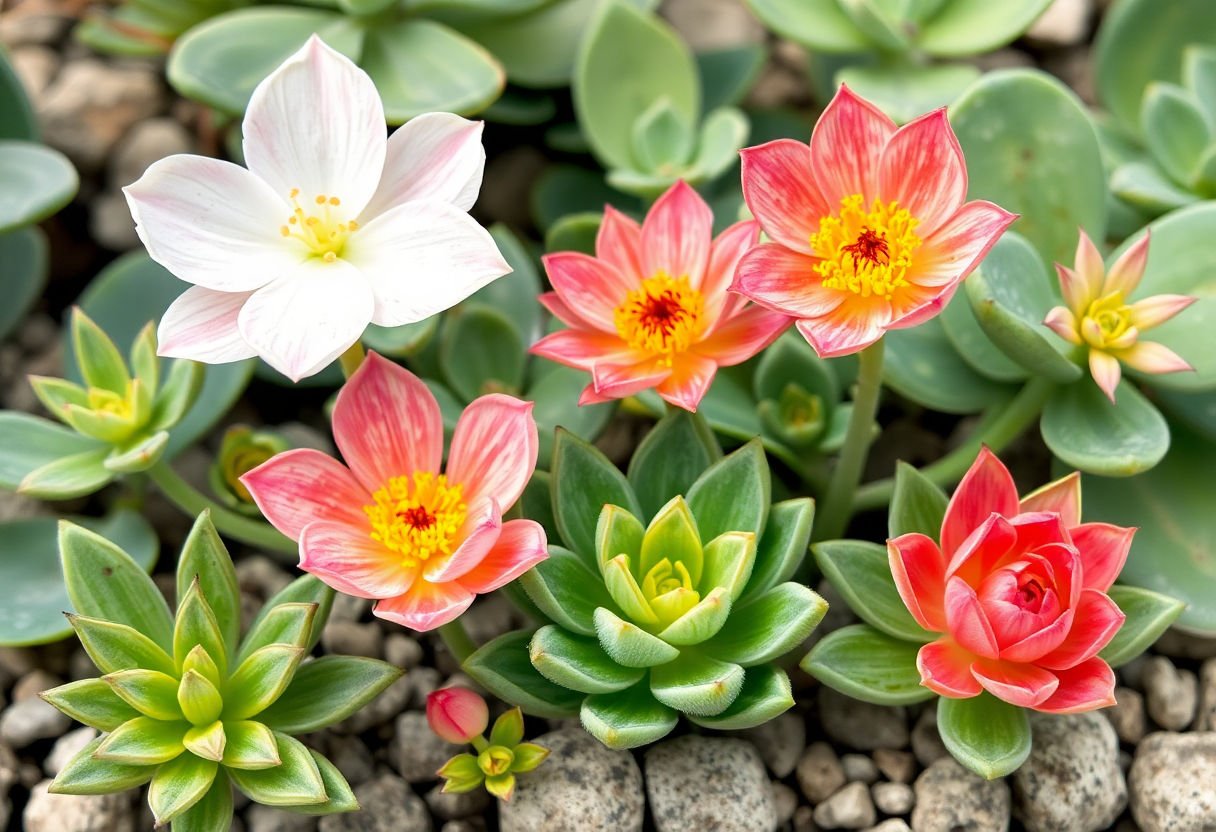Succulent plants, particularly the enchanting flowering varieties, have captured the imagination of many plant enthusiasts with their rumored healing abilities. As interest in natural remedies grows, these captivating plants are credited with a range of health benefits, from enhancing air quality to providing skin-soothing properties. This article delves into the myths and facts surrounding the purported therapeutic uses of flowering succulents, exploring their historical significance, scientific research, and practical applications in modern medicine. Join us as we separate fact from fiction and provide insights on safely integrating these botanicals into your wellness routine.
Key Takeaways
- The healing properties of flowering succulents have been a topic of interest, yet many claims are rooted in myths rather than scientific evidence.
- Understanding the traditional uses of succulents helps distinguish between cultural practices and medicinal efficacy.
- Scientific research offers mixed results; while some succulents exhibit beneficial properties, others lack substantial evidence.
- Incorporating succulents into modern medicine shows potential, but practical applications require careful consideration of potential side effects.
- For safe integration into health routines, it is crucial to prioritize scientifically-backed succulents and remain aware of risks involved.
Understanding Flowering Succulents
Flowering succulents are a fascinating subset of the succulent family, characterized by their ability to bloom and thrive in arid conditions. These plants are celebrated for their vibrant blooms that add a splash of color to spaces while maintaining the typical characteristics of succulents such as thick, fleshy leaves that store water. This resilience makes them particularly appealing as ornamental plants in regions with limited rainfall.
The allure of flowering succulents owes much to their unique aesthetic and low-maintenance requirements. Their flowers often come in a range of hues—from subtle pastels to bold, bright shades—providing a striking contrast against the rich green foliage. Some popular varieties include the Kalanchoe, known for its clusters of tiny, colorful blooms, and the Echeveria, which delights with its stunning rosettes and occasional flowers.
Beyond their visual appeal, these plants are believed to offer various wellness benefits, although evidence supporting these claims is largely anecdotal. Their potential for air purification is one such claim, enhancing indoor environments by releasing oxygen and absorbing toxins. Flowering succulents are also used in some natural remedies and wellness practices, revered for their supposed calming effects and ability to foster concentration and productivity.
From a cultural perspective, flowering succulents have been integrated into traditional healing practices for centuries. Their primal beauty, coupled with alleged medicinal properties, ensures they remain subjects of both admiration and intrigue. Whether displayed as decorative pieces or integrated into wellness routines, these resilient plants continue to captivate and inspire, underscoring their perpetual popularity.
Historical Uses of Succulents
Throughout history, succulent plants have been valued not only for their unique appearance but also for their medicinal properties. Various cultures around the world have harnessed these resilient plants, particularly those that bear flowers, for a myriad of health-related uses.
In ancient Egypt, records show the aloe vera plant—often referred to as the “plant of immortality”—being used to treat burns and skin infections. Its thick leaves, filled with a gelatinous substance, were prized for their soothing qualities. Egyptian medicinal texts from as early as 1550 BCE mention aloe’s usage, showcasing its longstanding medicinal heritage.
Similarly, in traditional Chinese medicine, succulents like golden tea lily (Huàng jīn nián) were integrated into remedies aimed at promoting general vitality and calming inflammation. These plants were often used in concoctions intended to purify blood and were believed to have balancing properties that aligned with the concepts of yin and yang.
The indigenous peoples of the southwestern United States have also utilized succulents, such as the prickly pear cactus, in their healing practices. Extracts from the cactus have been used to alleviate symptoms of inflammation, wounds, and digestive issues. The pulp of the prickly pear was applied as a poultice to speed the healing of cuts and bruises.
In Mediterranean regions, succulents like houseleek (Sempervivum tectorum) were traditionally planted on rooftops to ward off lightning strikes, symbolically extending their protective qualities to health, particularly in treating ailments like insect bites and shingles.
These historical uses underscore a long-standing belief in the potent healing properties of succulents, laying a foundation for modern interpretations and applications.
Common Healing Myths
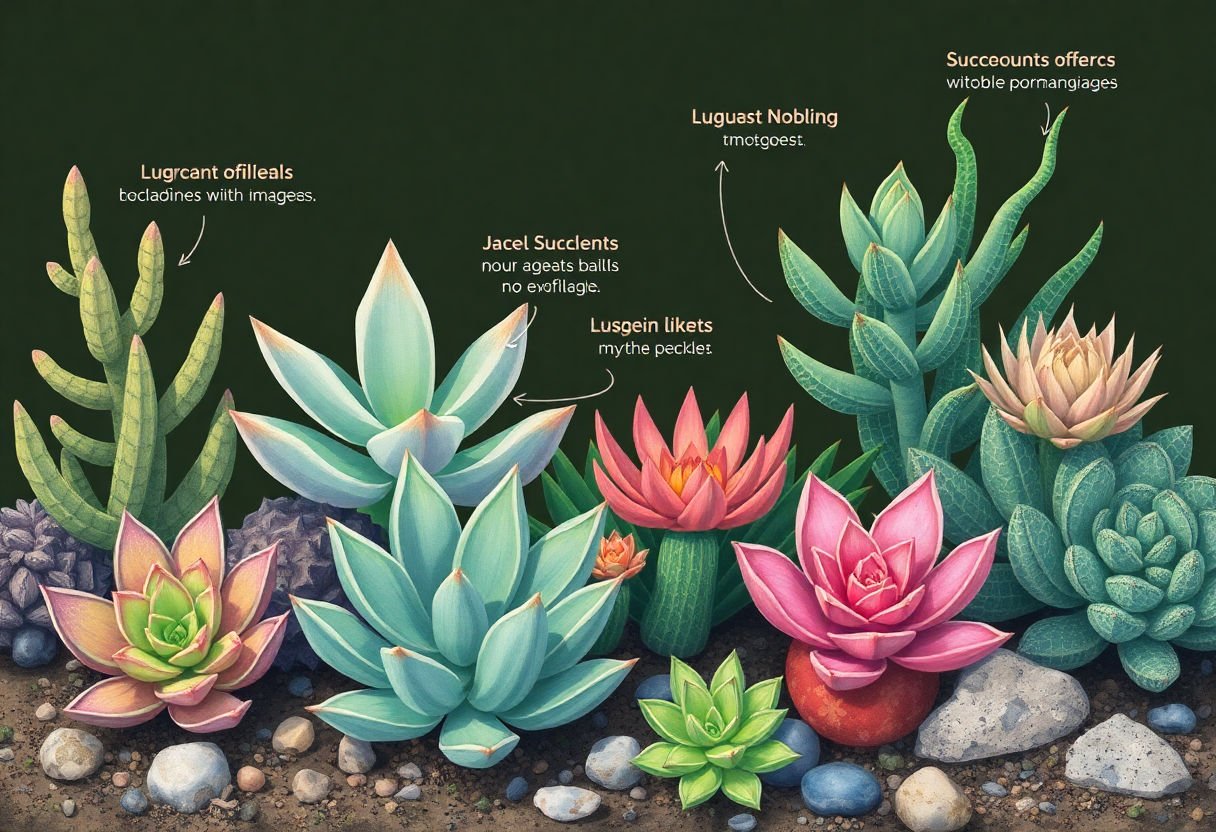
One pervasive myth is that all succulents possess medicinal properties, which is a common misconception that leads to generalization. While it’s true that aloe vera, a well-known succulent, has been studied for its benefits, this doesn’t imply that every succulent shares similar qualities. It is crucial to discern between folklore and fact, as not all succulents are inherently therapeutic.
Another myth is that succulents can cure serious ailments like cancer or diabetes. This oversimplification often stems from anecdotes that lack scientific backing. While succulents can contribute to a holistic wellness regimen by offering mild anti-inflammatory and antioxidant properties, they should not replace professional medical treatment for severe diseases.
A belief exists that succulents require little to no care and will thrive in any environment while providing health benefits. In reality, these plants demand specific conditions to maintain their properties. Factors like appropriate sunlight, temperature, and water are essential for their vitality, affecting the potential benefits they might offer.
There’s also a myth about the detoxifying power of succulents, suggesting that they purify the air to an extent that significantly affects indoor pollution. Although succulents can indeed filter some toxins, their impact is minimal and insufficient to replace conventional purification methods.
Finally, the notion that succulents are inherently safer than traditional pharmaceuticals often emerges from a misunderstanding of natural remedies. Although natural, succulents can cause allergic reactions or interact with medications. Consulting with a healthcare provider before using any succulent for medicinal purposes is advisable to avoid unforeseen complications.
Scientific Research on Succulents
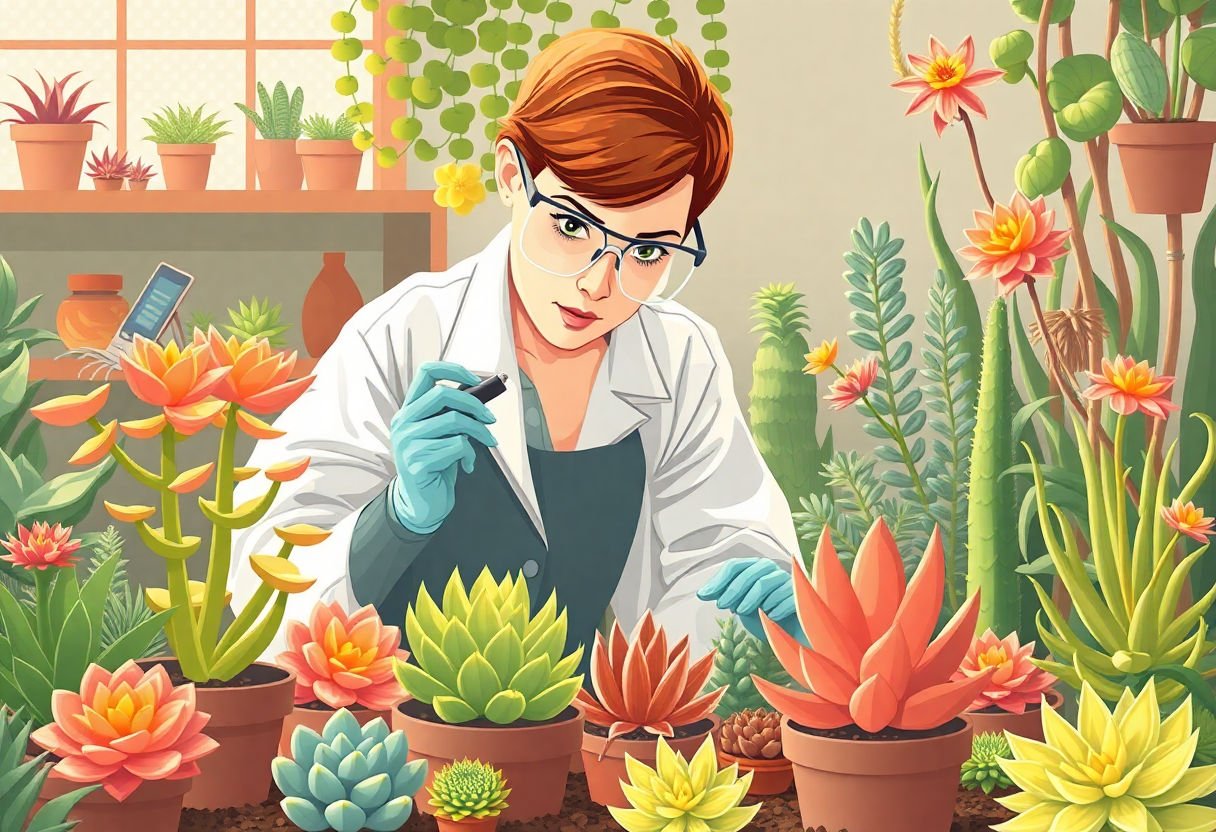
Scientific research into the purported healing properties of flowering succulents remains a developing field, with various studies exploring their biochemical potential. Succulents, characterized by thick, fleshy tissues adapted to water storage, exhibit unique compositions that may contribute to health benefits.
One significant focus is the Aloe Vera plant, known for its cooling and soothing properties. Extensive studies have explored its gel, rich in vitamins, enzymes, and amino acids. A study published in the Journal of Dermatological Treatment highlighted Aloe Vera’s efficacy in reducing inflammation and promoting skin hydration. Moreover, its antiviral and antibacterial properties are under scientific examination to validate traditional medicinal uses.
Another succulent, Sedum, contains fibrin that may assist in wound healing. Research indicates potential benefits in accelerating epithelialization and vascularization, though more rigorous clinical trials are necessary to confirm these findings conclusively.
The Kalanchoe species, often used in folk medicine for its purported anti-inflammatory and immune-boosting properties, has drawn scientific interest. Preliminary studies suggest that compounds derived from Kalanchoe may modulate immune response and exhibit antioxidant activity.
Despite promising preliminary results, it is crucial to underscore that much of the current evidence is preliminary or conducted on animal models. The complexity of biologically active compounds in succulents necessitates further research to establish their efficacy and safety in humans. The scientific community continues to call for more in-depth and controlled studies to separate fact from folklore concerning succulent healing properties.
Specific Succulents Known for Healing
Several succulent species are acclaimed for their potential therapeutic properties, rooted in both cultural traditions and emerging scientific exploration. Below are some of these noteworthy succulents:
-
Aloe Vera: Often called the “plant of immortality,” Aloe vera is distinguished by its fleshy leaves filled with a gel-like substance. This gel is renowned for its ability to soothe skin irritations, heal wounds, and alleviate burns. Its anti-inflammatory and antibacterial properties have made Aloe vera a staple in both folk medicine and modern skin care products.
-
Echinopsis Pachanoi (San Pedro Cactus): Traditionally used by indigenous cultures in South America, this cactus is famous for its psychoactive properties. It has been employed in spiritual rituals and is believed to possess antioxidant and anti-inflammatory benefits, though its primary use remains largely ceremonial.
-
Bryophyllum Pinnatum (Miracle Leaf): Widely regarded in African, Indian, and Latin American herbal medicine, the Miracle Leaf is celebrated for its purported ability to heal wounds, treat infections, and manage respiratory issues. Extracts from its leaves are thought to possess antimicrobial and hemostatic characteristics.
-
Sedum: Certain varieties of Sedum, like Sedum acre, have been used in traditional European medicine for their diuretic and anti-inflammatory effects. Although not widely supported by contemporary research, these plants continue to be a component of natural remedies for alleviating minor health issues.
The documented experiences and potential health benefits associated with these succulents provide a fascinating glimpse into the intersection of traditional practices and modern science. These plants continue to intrigue those seeking natural alternatives for healing, prompting further scientific investigation into their full range of properties.
Practical Uses in Modern Medicine
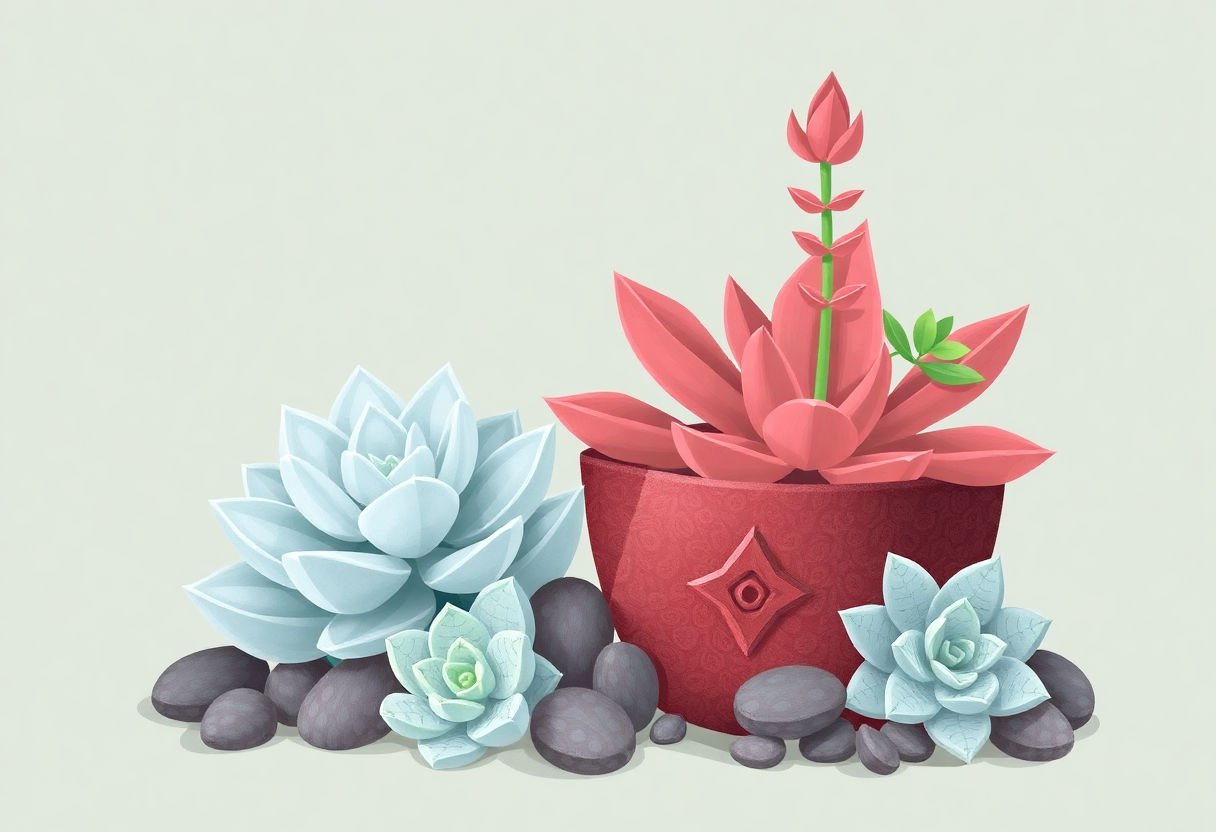
Flowering succulents have garnered attention in modern medicine for their potential therapeutic benefits, aligning with a broader movement toward integrating natural remedies into conventional healthcare. One remarkable application lies in wound healing. Succulents such as Aloe vera are renowned for their ability to expedite the healing process. Aloe vera gel, for instance, is used extensively in topical treatments for burns and minor cuts, providing soothing relief and promoting faster tissue regeneration. Its anti-inflammatory properties are particularly beneficial in reducing swelling and irritation.
Another promising aspect is the use of succulents in dermatological care. The moisture-retaining properties of succulent leaves make them an excellent ingredient in skin care products aimed at hydrating and rejuvenating the skin. Notably, the cosmetic industry has embraced the use of succulents like calendula, known for its skin-soothing attributes, in various creams and lotions.
Incorporating succulents into respiratory health treatments is an emerging field. Certain succulent species generate natural compounds that exhibit expectorant properties, aiding in the alleviation of symptoms associated with respiratory conditions. These natural treatments are seen as complementary to traditional methods, offering a gentler alternative for patients with sensitivities to synthetic medications.
Additionally, mental health therapies have seen an introduction of succulents due to their mood-enhancing capabilities. The presence of plants can induce calm and reduce stress, making succulent-based environments popular in therapeutic settings.
These practical applications underscore the value that flowering succulents bring to modern medicine, bridging the gap between ancient practices and contemporary therapeutic innovations.
Potential Side Effects

Potential side effects of using flowering succulents medicinally are often overlooked due to their natural origin and longstanding reputation for safety. However, understanding these risks is crucial for their safe and effective use in health practices.
Firstly, while many succulents like Aloe Vera are known for their soothing properties, skin irritation can occur in sensitive individuals. Prolonged exposure or excessive topical application can result in redness, itching, or a burning sensation. Testing a small patch of skin before broader application is recommended.
Ingesting succulents can also pose risks. For example, despite its popularity, Aloe Vera can cause gastrointestinal distress if consumed incorrectly. Consuming the latex component of Aloe can lead to cramping, diarrhea, and even electrolyte imbalance when taken in large quantities. Moderation and use of the inner gel are advised to mitigate these adverse effects.
Moreover, certain succulent extracts may interact negatively with medications. Bioactive compounds present in some succulents could potentially alter the effectiveness of prescribed drugs, particularly those metabolized by the liver. Physicians should be consulted prior to combining succulents with any form of medication.
Allergic reactions, although rare, are another potential side effect. Symptoms such as sneezing, a runny nose, or even respiratory issues may arise, particularly when succulents are in bloom, releasing pollen into the environment.
Incorporating succulents into one’s health regimen should be approached with caution and a good understanding of both the benefits and potential harms. Doing so ensures a safe and positive experience with these botanicals.
Integrating Succulents into Your Routine
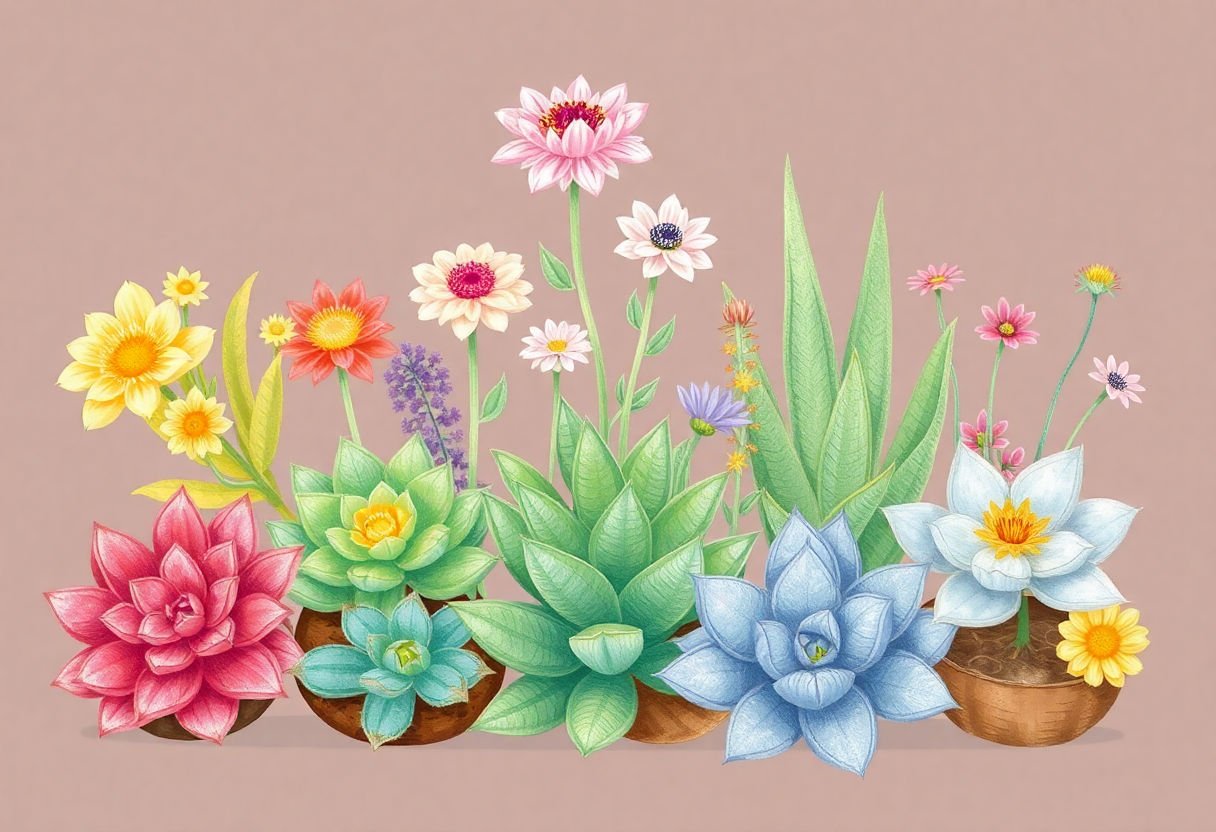
Integrating succulents into your daily routine can offer a refreshing and natural way to enhance your well-being. Succulents, known for their aesthetic appeal and minimal care requirements, can seamlessly blend into your living space, offering both visual beauty and potential health benefits.
To integrate these plants into your lifestyle, consider placing succulents in areas where you spend most of your time. A desk succulent garden can purify the air during long working hours, creating a more comfortable work environment. Similarly, positioning them in the bedroom may contribute to better air quality, possibly enhancing sleep by releasing oxygen at night.
Using succulent extracts in skincare is another innovative way to benefit from these plants. Certain varieties like Aloe Vera are renowned for their hydrating and soothing properties. Aloe Vera gel can be applied directly or found in various commercially available creams and lotions designed to nourish and protect the skin.
For those interested in wellness routines, crafting herbal teas from succulents such as Agave can be an enriching experience. Agave nectar, when used in moderation, offers a natural sweetener alternative, potentially reducing reliance on processed sugars.
When handling succulents, it is crucial to be aware of any potential allergies or skin sensitivities, particularly if using the plants topically or in food products. Consultation with a healthcare professional is advised to avoid adverse reactions.
In summary, incorporating succulents into your routine embraces both functional and therapeutic dimensions, positioning these resilient plants as both a decorative and a potentially beneficial addition to a holistic lifestyle approach.
Conclusion
In examining the healing properties of flowering succulents, it becomes clear that while there are traditional uses supported by anecdotal evidence, scientific validation remains limited. The allure of succulents lies not only in their beauty and resilience but also in the blend of myth and fact surrounding their potential health benefits. As research progresses, modern medicine might uncover novel applications for these plants, bridging past traditions with future innovations. Meanwhile, it is advisable to integrate succulents into wellness routines with caution and awareness of their potential side effects.
Frequently Asked Questions
Are flowering succulents effective for treating skin conditions?
Flowering succulents, particularly Aloe Vera, have been traditionally used for soothing mild skin irritations and sunburns. While moderate benefits are acknowledged, it’s essential to consult with a dermatologist for medical concerns as scientific validation varies.
Can consuming succulents improve digestion?
Some succulents, like Aloe Vera, are thought to aid digestion, but they must be consumed correctly and in appropriate amounts. It is crucial to be informed about potential side effects and use them under professional guidance.
Do flowering succulents have any proven stress-relief benefits?
While the mere presence of plants, including succulents, can create a calming environment, direct scientific evidence linking flowering succulents specifically to stress relief is limited. Their natural beauty, however, may contribute to emotional well-being.
Are there any risks associated with using succulents medicinally?
Yes, while most succulents are safe, using them medicinally without caution can lead to adverse reactions, especially in their raw form. Some varieties may cause allergic reactions or gastrointestinal distress if improperly prepared or consumed.
How should succulents be incorporated safely into health routines?
To safely include succulents in health regimens, start with widely recognized varieties like Aloe Vera and follow proper usage guidelines. Consultation with a health professional is recommended to tailor their use to specific health needs.
